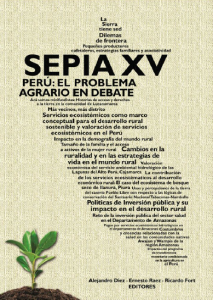Políticas de inversión pública y su impacto sobre el desarrollo rural: estrategias y mecanismos de implementación en la última década
Perú: el problema agrario en debate. Sepia XV
| Year | : | 2014 |
|---|---|---|
| Author/s | : | Ricardo Fort |
| Area/s | : | Rural development and agriculture, State reform and public institutions, Health and nutrition |
Fort, R. (2014). Políticas de inversión pública y su impacto sobre el desarrollo rural: estrategias y mecanismos de implementación en la última década. En A. Diez, E. Raéz y R. Fort (Eds.), Perú: el problema agrario en debate. Sepia XV (pp. 423-496). Lima: Sepia.
Our objective in this paper is to take stock of the various studies published that show the evolution over the last decade of some of the main public investment policies, as well as the impacts they have been generating, with the aim of contributing to the discussion on the functioning of the orientation being taken in these fields, and to indicate whether it is possible to observe a certain alignment between the consensus regarding the practices and considerations necessary for successful rural development, and the design and implementation of programmes from the public sector. After this assessment, we will try to gather information from recent studies on what is happening in sub-national governments —especially in rural municipalities— with investment planning processes, and what are the main challenges that coordination between levels of government is facing. We will focus on the relationship between planning instruments such as the concerted development plans (PdC for its acronyms en Spanish) and mechanisms that are becoming increasingly important, such as the participatory budget (PP for its acronyms en Spanish) and the budget for results (PPr for its acronyms en Spanish), in order to raise elements for discussion on how to ensure that these mechanisms dialogue in such a way as to facilitate coordination between sectors and levels of government, as well as the alignment of all actors to shared strategies. Finally, we will offer some final reflections with the intention of ordering various issues that will emerge from the assessment for future discussion and to highlight research gaps.







